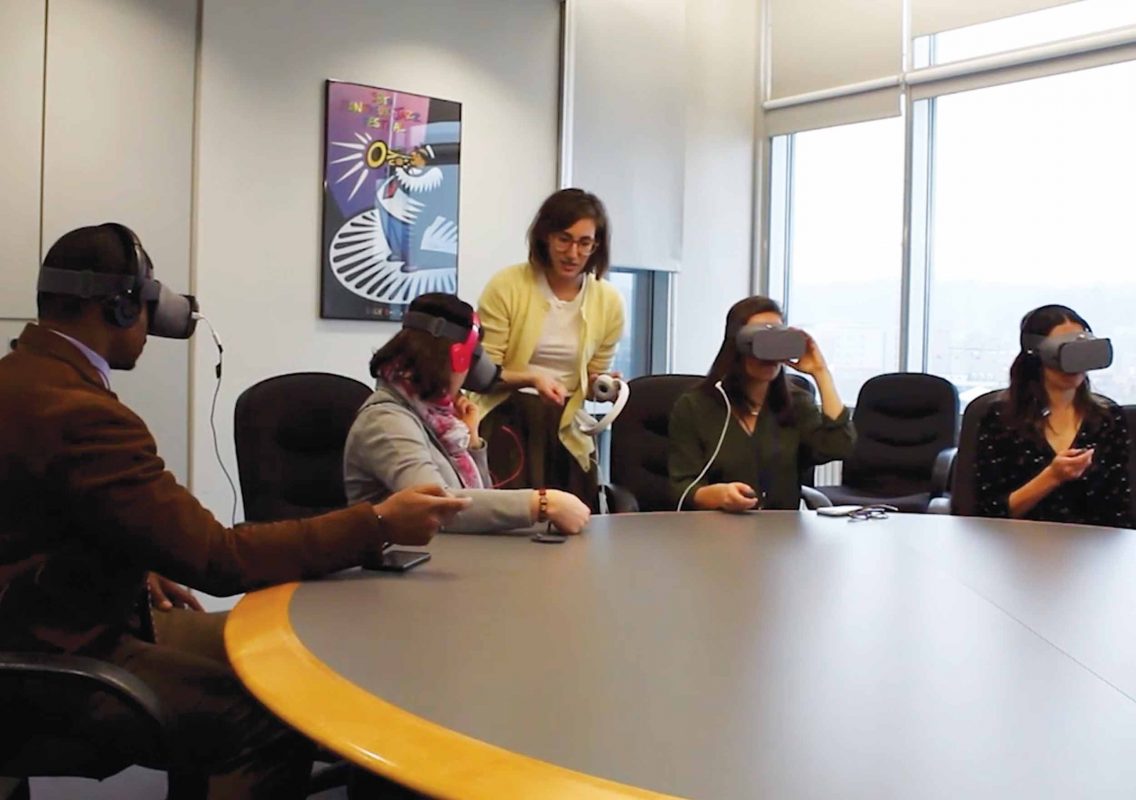Before you put on the headphones and virtual reality headset, you’re asked to forget who you are.

Otherwise, you aren’t told much — just that the control in your right hand allows you to interact with the animated world of “Thin Line.” And then it begins, and you, the main character, are helping your parents move out of your childhood home.
This conceit allows you to learn a lot of information quickly through memories sparked by the objects you pack — you have a close relationship with your sister; you liked imagining yourself as a character in the bible stories you heard at church as a kid; you were incredibly shy in high school; you didn’t have your first boyfriend until college.
When you got pregnant, you decided to have an abortion because you weren’t ready to have a baby. The first doctor you saw said he didn’t perform abortions and that you should consider adoption if you didn’t want to keep it. You made an appointment to terminate the pregnancy at a hospital so you’d feel just like any other patient, but on the day of the operation, the nurse kept asking if you were sure you didn’t want to see your baby on the ultrasound. Years later, when you went to a new gynecologist to talk about getting pregnant with your husband, you were ashamed to mention the abortion. You finally did, and the doctor simply said that it was “a normal part of reproductive healthcare” and moved on to prenatal vitamins. She offered no judgment, one way or the other.
The message of “Thin Line” is clear and straightforward. Its final credit screen even reads, “All women deserve equal care.” But its delivery and goals are anything but straightforward. Its creators hope it will be used in a training program to help reduce bias toward women who’ve had abortions. And participating in the roughly 10-minute experience means not just learning about someone’s abortion, but living it — feeling their lack of choice, their desperation, their stigmatization, their relief.
To achieve this, “Thin Line” uses experience-taking, a term coined by Geoff Kaufman and Lisa Libby in a 2012 paper, which asks participants to assume the identity of a fictional character. In a series of six studies, Kaufman and Libby explored how intentionally heightening what naturally happens when we read first-person accounts — increased relatability — can lead to increased understanding. They found that employing specific tools increased the ability of a participant to take on another’s identity, which ultimately led to better understanding and changes in the participant’s attitudes and behaviors.
Participating in “Thin Line” means not just learning about someone’s abortion, but living it — feeling their lack of choice, their desperation, their stigmatization, their relief.

Rony Kahana came from Israel at the age of 29 for the master of entertainment technology degree at Carnegie Mellon University’s Entertainment Technology Center in Pittsburgh. The ETC is unique in that it accepts students from various backgrounds — gaming, design, technology, the arts, business, writing, and other creative storytelling fields. Kahana is one of those creatives. She always knew she wanted to end up in games, but spent her 20s on the creative side, making short films based on her own experience and starting a film festival. At CMU, she focused on interactive storytelling. For her final project in the spring of 2018, she decided to explore the lack of choice felt by women all over the world.
“In Israel, there’s no separation of religion and state,” she explained, “so women are pushed aside a little. Not in an extremist way, but women are definitely considered second-class.” She wanted a way to make people feel that, and a virtual reality experience about the right to choose in America seemed like a good way to do it. So she recruited four other international grad students and they hustled to make “Thin Line” over the next 15 weeks.
At the insistence of her adviser, Kahana showed Kaufman an early version of “Thin Line.” Kaufman said that it “revealed the plight of the character very quickly,” which didn’t give the player time to connect with the protagonist. He encouraged Kahana to be stealthy and wait until the participant was in a “more receptive mindset.”
The “Thin Line” team set about incorporating the tools Kaufman and Libby found to increase experience-taking. Perhaps most importantly, you don’t learn about the abortion until about halfway through, what Kaufman and Libby call “delayed revelation.” The first five minutes are spent getting to know her while packing mementos from her childhood, so that by the time the abortion is revealed, you already care about her — you are invested in her story and you relate to her.
In addition to asking you to actively let go of who you are before you begin “Thin Line,” they work to “reduce self-concept” within the game. You receive a call from “Dad” on your iPhone. Because you never see him, you can imagine your own father. And because you answer the phone, but never see your arm, your skin can be any color. When your memories play out before you, they are done in silhouette so you can project your own image.
The identity you were asked to leave behind is replaced by the protagonist. It’s literally from the first-person perspective —everything you see is from her eyes as though you are in her body. All the monologues are in-first person, and when you move from the house to scenes in doctors’ offices, they talk directly to you. In essence, you become her. You also learn that she is a medical student, and because the target audience for “Thin Line” is medical professionals and trainees, this commonality makes it easier for you to identify with her. Kaufman and Libby call this the “ingroup identity,” which helps ease the difference of the “outgroup identity” of the abortion.
It seems like VR would be the natural choice for experience-taking because it’s so immersive, but “Thin Line” is the first example of it. Trisha Surve, one of the team’s designers and programmers, explained that first person is hard to achieve in VR because “the moment you sense something is off, it throws you out of the experience.” Through weekly playtests, the team got feedback on what pulled players out. They put a lot of thought into objects. Because the team consisted of international students, they each made a list of childhood objects and cross-referenced them. They were left with a short, ubiquitous list.
The design was, in a way, about achieving the perfect combination of general and specific. The teddy bear was specific to the protagonist, but if you had a doll or a blanket as a kid, you can easily substitute it. The protagonist went to “church,” but not a specific denomination. Surve explained that the medical professionals were all faceless because motion capture for facial expressions is very expensive. But it also adds to the could-be-anyone factor.
Most teams at ETC playtest four to five times during a semester, but the relentless playtesting of “Thin Line” (15 times in all) meant they perfected the tone of these faceless medical professionals, the objects, what the house looked like, and the narrative to ensure players wouldn’t be thrown out of the game by anything that too strongly brought back a sense of self.
But how much do we really need to worry about being manipulated? We’re manipulated all the time — by Netflix and books and Facebook and advertisements — and we seem to get by all right.

It’s hard to determine the true impact of “Thin Line.” Anecdotally, it works. Since completing it last May, Kahana has toured “Thin Line” at eight conferences. It’s won awards. And, according to Kahana, players say they feel emotionally invested and relieved by the kindness and professionalism of the final doctor — that the message is important even when they don’t agree with the character’s decision. It’s also being considered as part of a training program, but before that can happen, its efficacy needs to be measured in a rigorous study. In such a study, Kahana said they need to look at two main things. “One, is it useful that it’s in VR versus other mediums? And two, does it create change? Does it make participants more accepting? Does it open them up? Reveal their implicit biases?”
In the 2012 paper, Kaufman and Libby warn that experience-taking could be used for ill. “Engaging in experience-taking with characters who perform ethically or legally questionable behaviors … could arguably cause individuals to be more accepting or tolerant of such characters or more willing to deny or trivialize the risk,” they wrote. But how much do we really need to worry about being manipulated? We’re manipulated all the time — by Netflix and books and Facebook and advertisements — and we seem to get by all right.
Experiencing “Thin Line” isn’t going to magically turn you in favor of abortion rights against your will. For one thing, it’s not the goal. The goal is to reduce bias, asking that providers see that they can disagree ideologically with a patient and still treat them with respect. But also, it’s just not that powerful. It deceives you by asking that you care about someone different than you. It doesn’t trick you into changing your mind.
“Thin Line,” at most, opens the door a crack, and after the experience, you have to be willing to engage, to push that door open further. As Kaufman said, “You have to be willing to examine your own bias.”







